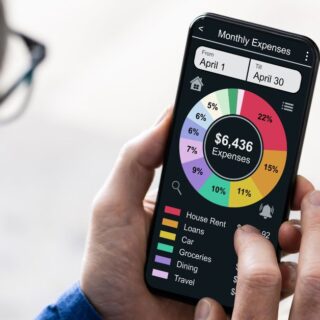The 9 best fitness apps of 2025
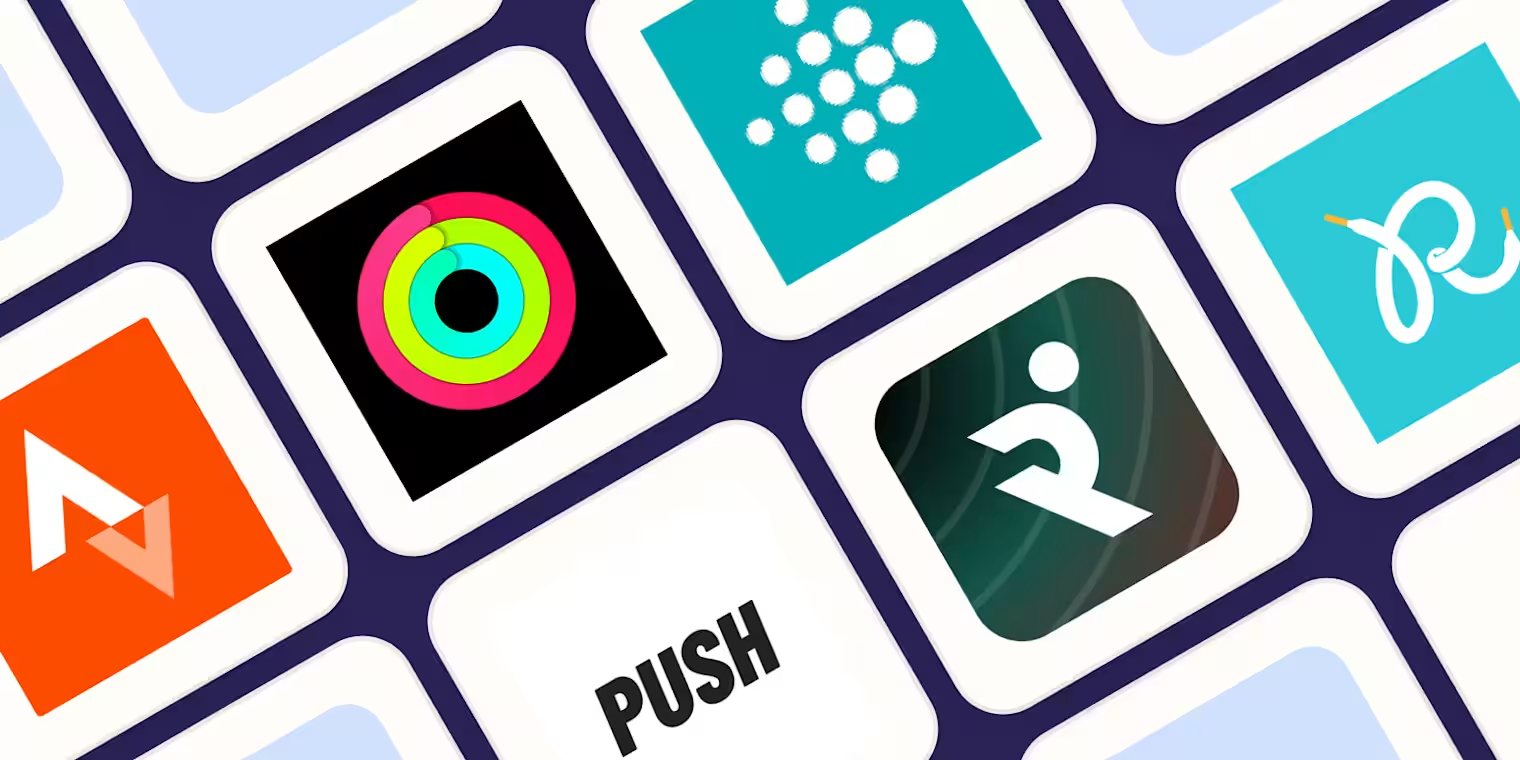
With so many fitness apps flooding the market, it’s easy to feel overwhelmed. There seems to be a fitness app for everything, from logging your personal records to tracking your pickleball victories, each catering to a specific need.
While this variety is great for offering users options, it can often feel like you’re comparing entirely different things when choosing a new app. Staying fit is already a challenge, so your fitness app should simplify the process, not add complexity.
As someone who has experimented with nearly every workout style, I wanted to compile a reliable list of the best fitness apps out there. After reviewing more than 25 apps, ranging from running trackers and weightlifting journals to all-in-one activity monitors, I’ve narrowed it down to the nine best apps—each excelling in its own area.
What Makes the Best Fitness App?
Before diving into my research on the top fitness apps, I took some time to reflect on the key traits that all great fitness trackers share, no matter their focus. After considering different factors, I identified four essential qualities:
- Ease of Use: The app should be simple to start, stop, and log activities. Extra points if it tracks overall physical activity, such as daily steps or basal metabolic rate (BMR), not just workouts. Bonus if it also allows for workout planning ahead of time.
- Relevant Metrics: The best apps track metrics that match the activity, like heart rate, calories burned, distance, splits, elevation, weights, and personal records (PBs/PRs). It’s a plus if the app supports multiple workout types.
- Accuracy: The app’s results should be reliable and accurate. If it syncs well with wearables like an Apple Watch, it can significantly improve precision.
- Affordability: Since you’re already investing in a gym membership or fitness equipment, the best fitness tracker shouldn’t add too much to the overall cost of staying fit.
To ensure a fair evaluation, I tested each app in a consistent way:
- For running and cardio apps, I used them during a run or walk of at least one mile. Due to the winter weather where I live, most testing took place indoors on a treadmill, which provided a reliable baseline for comparing app data.
- For strength-training apps, I followed either my regular routine or one suggested by the app.
- For apps tracking various workout types, I tested each with one cardio and one strength workout.
One type of fitness app I didn’t consider: apps primarily focused on accessing paid content or classes (like Blogilates or Peloton). While these apps are great for fitness routines, they don’t typically track fitness data and serve a different purpose.
With these criteria in mind, let’s explore the best fitness apps available.
Best Fitness App for Those Who Like a Little Competition
Strava (iOS, Android)
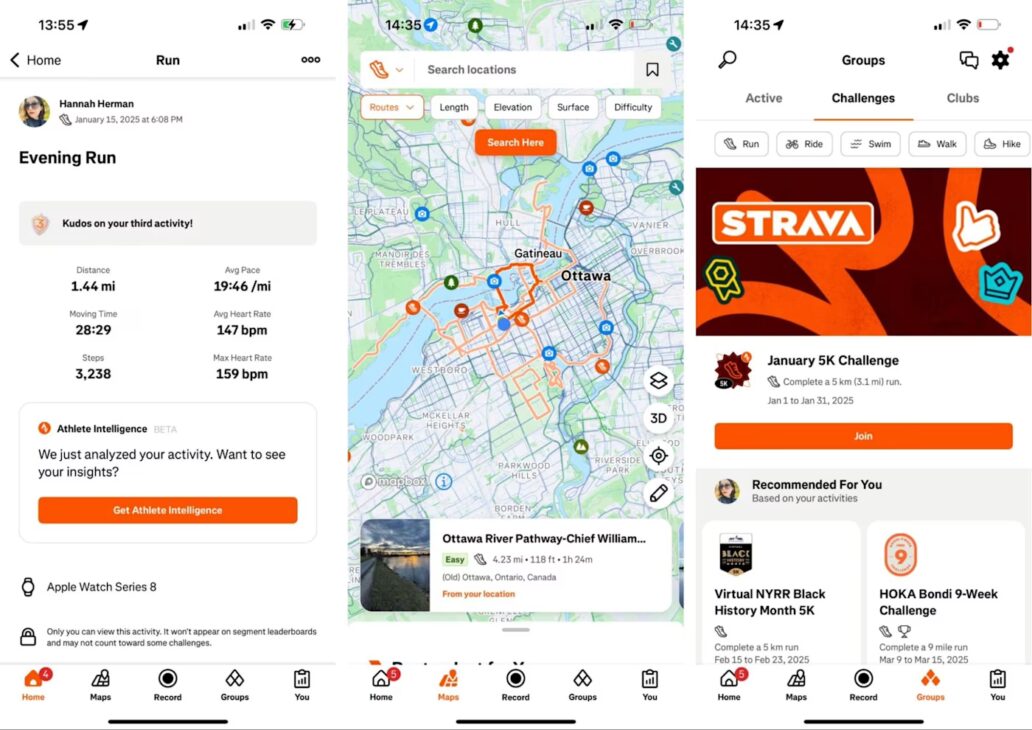
Strava Pros:
- Accurate mapping for outdoor activities
- Live beacon tracking for enhanced safety
- Strong social and community features
Strava Cons:
- Limited support for indoor workouts
- Basic wearable connectivity
If you’re someone who thrives on friendly competition, Strava might be the fitness app you’ve been looking for. Recently, a friend jokingly asked, “If you didn’t log it on Strava, did it even happen?” It’s a perfect example of the app’s cultural hold in the fitness world over the past few years. But does Strava truly live up to its reputation as the best fitness tracker?
What Makes Strava Stand Out: Strava excels when it comes to mapping outdoor activities such as running, cycling, and hiking. The app encourages social interaction by allowing you to follow friends, check out their recent activity, and discover popular routes nearby. With Strava Premium, you can access live beacon sharing for safety during longer outdoor workouts, along with relative effort tracking to monitor your fitness progress over time.
For cyclists, Strava integrates seamlessly with bike computers and indoor road bike trainers like Zwift—though this is something I didn’t test, I can see it being a huge advantage for cycling enthusiasts.
Strava’s Weaknesses: For those who prefer indoor activities like Pilates or weightlifting, Strava doesn’t offer much. Additionally, if you’re privacy-conscious or not interested in competition, many of Strava’s key features may seem unnecessary.
During my testing, I noticed that wearable connectivity was less impressive than I expected. Although the app accurately tracked basic metrics like pace and heart rate, it didn’t show splits or laps in real-time on my Apple Watch. To view those metrics, you’ll need to upgrade to Strava Premium and check them later in the app. This made it tricky to pace myself during longer runs.
Strava’s Integration with Other Apps: One of the best features of Strava is its ability to connect with thousands of apps via Zapier. This lets you automate the tracking of your workouts in tools like Google Sheets or Notion, making it easier to stay organized and manage your fitness progress.
Best Fitness Tracking App for Apple Users
Apple Fitness (iOS)
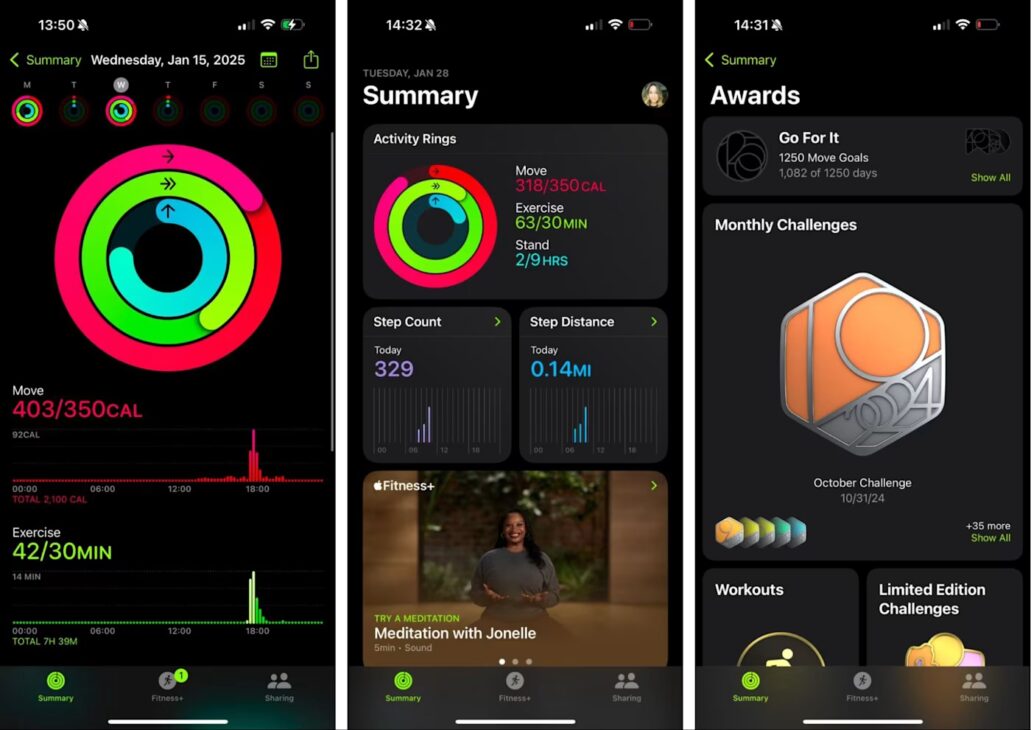
Apple Fitness Pros:
- Beautiful, user-friendly interface
- Seamless integration with Apple wearables
- Supports a wide range of workout types
- All key features are available for free
Apple Fitness Cons:
- Accuracy issues with less-common workouts
- Mediocre recovery tracking
- Not the best for strength training metrics
For those embedded in the Apple ecosystem, Apple Fitness is often the first app they turn to for tracking their fitness. Pre-installed and free with every iPhone, it offers a simple yet powerful way to track activity and workouts.
What Makes Apple Fitness Stand Out: Apple Fitness stands out with its intuitive and elegant interface, featuring three color-coded rings that track your active calories burned, exercise minutes, and hourly movement. It also tracks general activity, such as flights of stairs climbed and the frequency of standing up throughout the day. In typical Apple fashion, it’s simple to use and provides a clear overview of your fitness progress.
The workout tracking feature offers a variety of options, including popular workouts like Pilates and tennis. However, for some workouts, the calorie count defaults to that of a brisk walk. For running, it tracks mile splits, heart rate, pace, and allows you to manually mark laps. While it’s not the best at tracking strength training metrics (like reps or sets), it provides decent all-around support for varied fitness routines.
Limitations of Apple Fitness: To unlock its full potential, you’ll need an Apple Watch, which, while offering accurate tracking, comes with a significant price tag. Without the watch, the mobile app can still track steps and exercise calories, though it’s less precise, particularly if you often set your phone down during workouts.
One major downside is the app’s limited sleep and recovery tracking. Apple Fitness sets the same daily goal regardless of your sleep quality or workout intensity from the previous day, offering limited adjustments to these goals. Essentially, it focuses more on fitness tracking than recovery.
Apple Fitness Pricing: Free for basic features; paid plans start at $9.99/month for additional features.
Best Fitness Tracker App for Getting Started
Fitbit (iOS, Android)
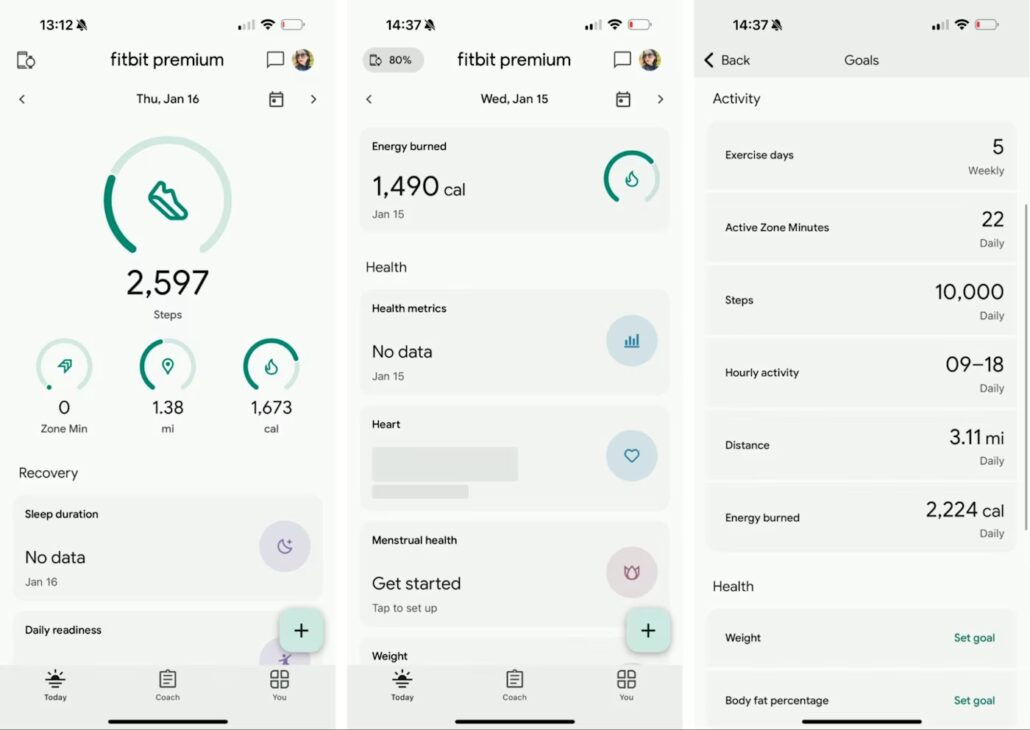
Fitbit Pros:
- Solid all-around activity tracking, including sleep and nutrition
- Achievement badges for motivation
- Daily readiness scores with a premium subscription
Fitbit Cons:
- Requires a Fitbit wearable for accurate tracking
- Manual tracking needed for some activities
If you’re looking for an accessible fitness tracker to kickstart your journey, Fitbit is a great alternative to Apple Fitness, especially if you’re not using an iPhone or Apple Watch. With a range of features, the app tracks not only activity but also sleep, nutrition, water intake, menstrual cycle, glucose, and weight—perfect for those aiming to improve their overall health. Like Apple Fitness, Fitbit offers achievement badges for motivation, letting you track personal milestones without competing against others. Plus, with a premium subscription, you get daily readiness scores to assess your overall wellness.
What Makes Fitbit Stand Out: Fitbit shines when paired with a Fitbit wearable, which provides much more accurate data than the app alone. While you can still track your steps with the app, its accuracy is limited. For example, during a treadmill session, it inaccurately measured my pace as 62 minutes per mile when I was walking at a 17-minute pace. The app also offers live and manual tracking, with live tracking covering just basic workouts like running, walking, hiking, and biking. For a broader range of activities, you’ll need to use manual tracking, which provides a longer list of options to choose from.
However, Fitbit doesn’t excel in tracking strength training metrics. If you’re primarily into strength workouts, it may not provide the granular data you need.
Fitbit is Perfect For: If you’re new to fitness or just starting to get into a healthy routine, Fitbit is an affordable and straightforward app to help track your progress. It covers more than just workouts and provides a reliable overview of your daily activity. While it doesn’t offer premium features right out of the gate, it’s a solid choice for those looking for an app that tracks more than just workouts.
Fitbit Pricing: Free for basic features; premium subscription costs $79.99/year or $9.99/month.
Best Fitness App for Science-Backed Gains
PUSH (iOS, Android)
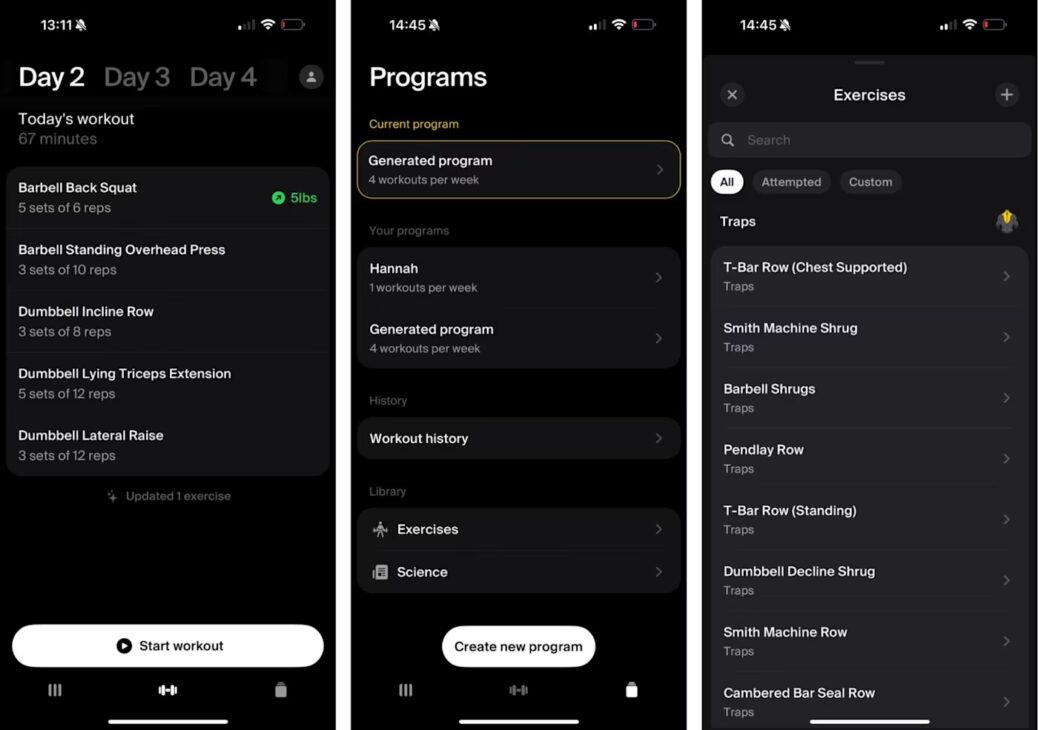
PUSH Pros:
- Personalized, science-backed strength training programs
- Predictive analytics to track future progress
- Sleek, user-friendly interface
PUSH Cons:
- Only tracks strength training, not cardio
- Not designed for freestyle workouts
- No wearable connectivity
If you’re looking for a fitness app that provides a structured, science-backed approach to strength training, PUSH is the perfect fit. Unlike apps that let you design your own workouts on the fly, PUSH relies on AI to generate a personalized strength training program based on the principles of progressive overload. It’s not for those who like to choose their workouts on a whim or alternate between cardio and strength training on the same day.
What Sets PUSH Apart: The app’s onboarding process is exceptionally smooth. It walks you through a series of questions to assess your strength training experience, goals, and preferred muscle groups to target. From there, it generates a tailored program for you to follow. Once you begin your AI-generated workout, the app makes it easy to track your progress and guides you through each set with intuitive prompts. It even lets you know when to take breaks, which helps maintain a structured training rhythm.
PUSH also incorporates predictive analytics, showing you how many sets it estimates you’ll need to enter the “growth zone,” a motivating feature that turns your training into a more rewarding and progressive experience.
Limitations of PUSH: While PUSH is fantastic for strength training, it’s not suited for tracking cardio or freestyle workouts. The app doesn’t offer wearable connectivity, so if you’re looking to track heart rate or other fitness metrics, you may want to consider a different option. It also doesn’t provide in-depth tracking for each workout beyond tracking personal records (PRs) and workout length, so it may not meet all your fitness tracking needs.
PUSH is Ideal For: Those who are serious about strength training and want a personalized, scientifically-backed program to help them progress. It’s perfect for users who are committed to a structured training routine and are looking for a straightforward way to track gains over time.
PUSH Pricing: From $13.49/month.
Best Fitness App for Race Training
Runna (iOS, Android)
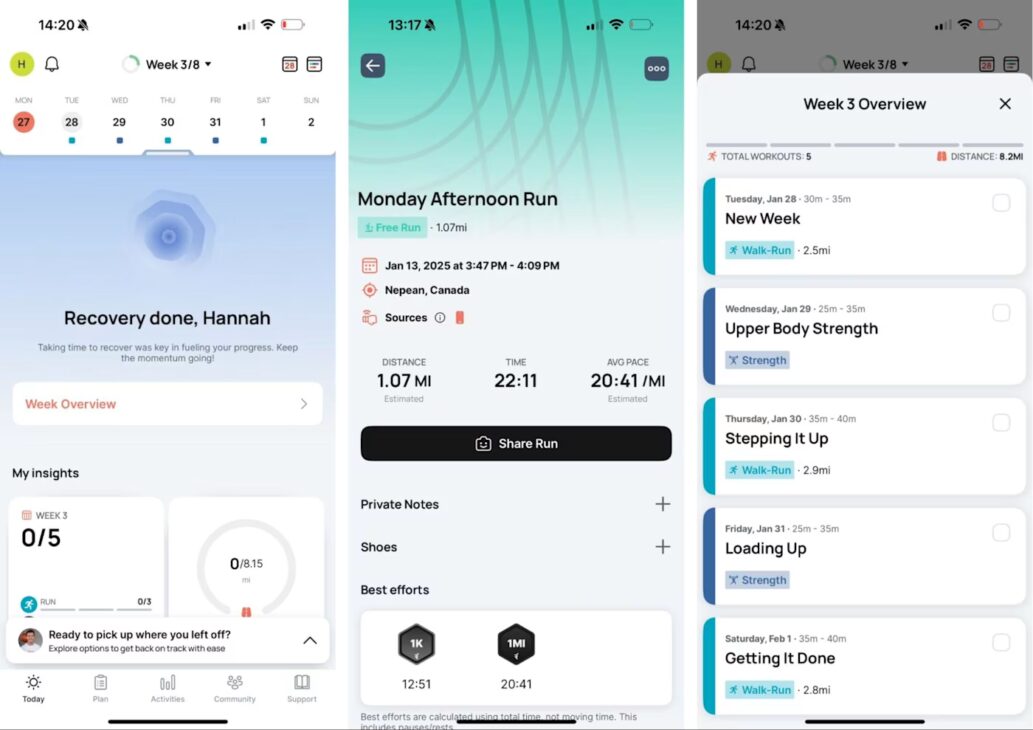
Runna Pros:
- Structured, goal-oriented training plans, including strength exercises
- Community groups for upcoming races
- Calendar sync feature to help you stay on track with your training
Runna Cons:
- Limited functionality for one-off runs
- Weak wearable connectivity
If you’re serious about race training, Runna is an app that can help you stay organized and motivated. While not the most well-known app, it’s quickly gaining traction for its comprehensive training plans designed to get you ready for races. Whether you’re training for a 5K or a marathon, Runna offers structured plans tailored to your fitness level and goals—complete with strength training, which many runners tend to overlook.
What Makes Runna Stand Out: Runna’s community-focused approach sets it apart. You can join groups with others training for the same race, which provides both support and a sense of camaraderie. Additionally, the calendar sync feature is a great help for busy athletes who need a little extra structure to stay on top of their training schedules.
Drawbacks of Runna: While it’s great for structured race training, Runna’s functionality falls short when it comes to one-off or casual runs. Starting a “free run” is a bit clunky, and the tracking can be inaccurate. Though you can manually adjust your run details afterward, this only works well if you have a good idea of your pace—like if you’re on a treadmill. When I tested it on my Apple Watch, the app still felt overly simplistic, and it even warned me that using the watch for tracking wasn’t recommended.
Runna is Ideal For: Runners looking for a structured and social way to train for an upcoming race without the need for a personal coach. It’s also a solid option if you need extra motivation and accountability through community support.
Runna Pricing: Free for basic features; paid plans starting at $19.99/month.
Best Fitness App for Strength Training
Strong (iOS, Android)
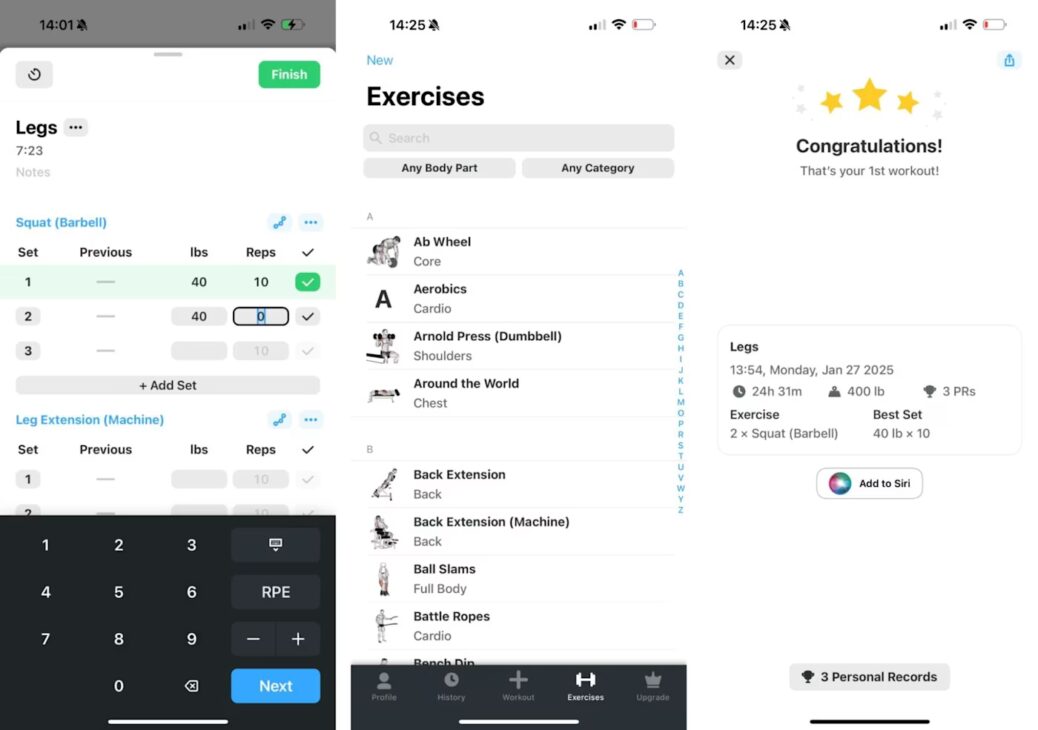
Strong Pros:
- Easy-to-use workout templates
- Comprehensive exercise library with instructional demos
- Premium subscription offers detailed analytics, including exercise volume and best set/PR tracking
Strong Cons:
- Focuses solely on strength training
- Not the best option for beginners
If you’re serious about strength training, Strong is one of the best apps out there. It’s a template-based app that allows you to select (or create) a custom workout plan, which you can save for future use. The user-friendly template creation interface makes it simple to set up your routine, and the extensive exercise library offers demos for a wide variety of movements—helping you explore new exercises to add to your regimen.
What Sets Strong Apart: The app offers valuable insights through its paid subscription, including analytics that track your progress, such as your best sets and personal records. This feature is great for anyone who wants to measure their strength gains over time.
Drawbacks of Strong: While it’s a fantastic tool for tracking your strength training, it may not be ideal for beginners. If you’re new to weight lifting, the app can feel overwhelming. While the exercise library is thorough, there’s no way to learn new exercises mid-workout. If you prefer to plan your sessions ahead of time, this isn’t a big issue, but it could become frustrating if you’re unfamiliar with an exercise and need to quickly reference instructions during your session.
Ideal For: Experienced strength trainers who want a solid way to track their progress and create personalized workout routines.
Strong Pricing: Free; paid plans start at $3.99/month.
Best Fitness App for Busy People
Hevy (iOS, Android)
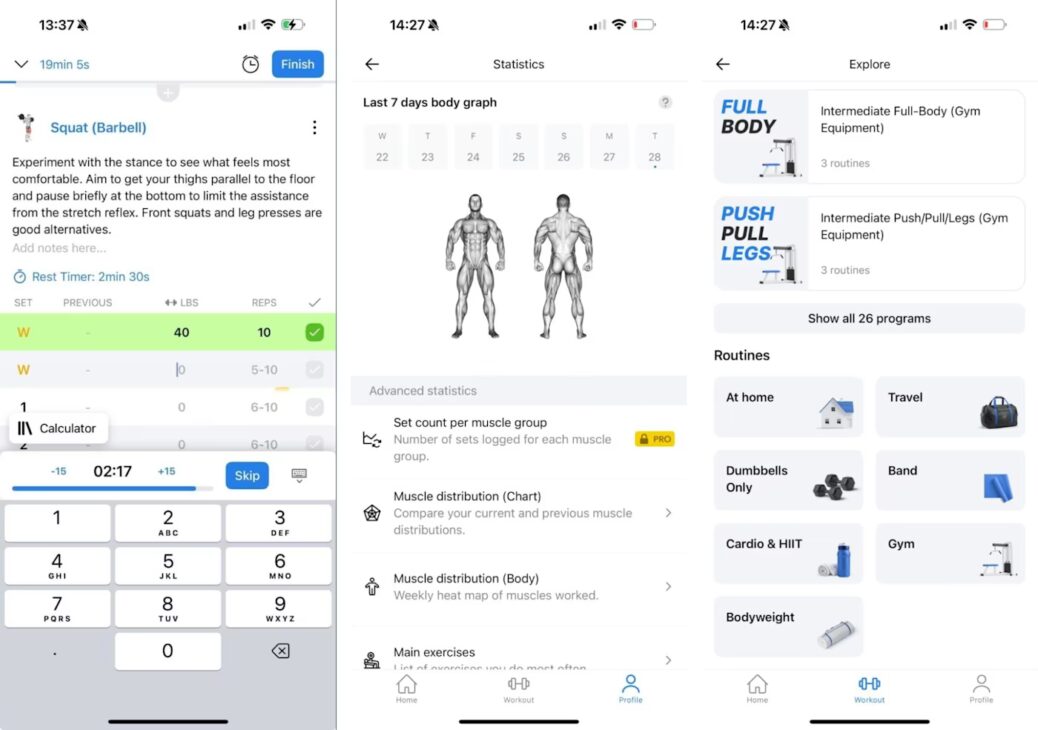
Hevy Pros:
- Offers both popular and custom workout routines
- Sorts workouts by location (home vs. gym) or available equipment
- Customizable rest trackers
Hevy Cons:
- Basic interface
If you’re someone who finds it challenging to maintain a consistent workout routine due to limited gym access—whether you’re frequently in hotel gyms or working out in your home office—Hevy might be the solution. This app shines in its ability to customize workouts based on location and equipment. I loved how easily I could select workouts tailored for home use or those requiring no equipment at all.
Key Features: Hevy also lets you freestyle your workouts, allowing you to add exercises and sets on the go. It synced well with my Apple Watch, so I could track everything without constantly checking my phone.
While the app may not have all the bells and whistles of other fitness apps, its simplicity and focus on helping busy people stay fit make it a great choice.
Ideal For: Those with busy schedules who need flexibility in their fitness routines.
Hevy Pricing: Free; paid plans from $2.99/month.
Best Fitness App for Running Beginners
Runkeeper
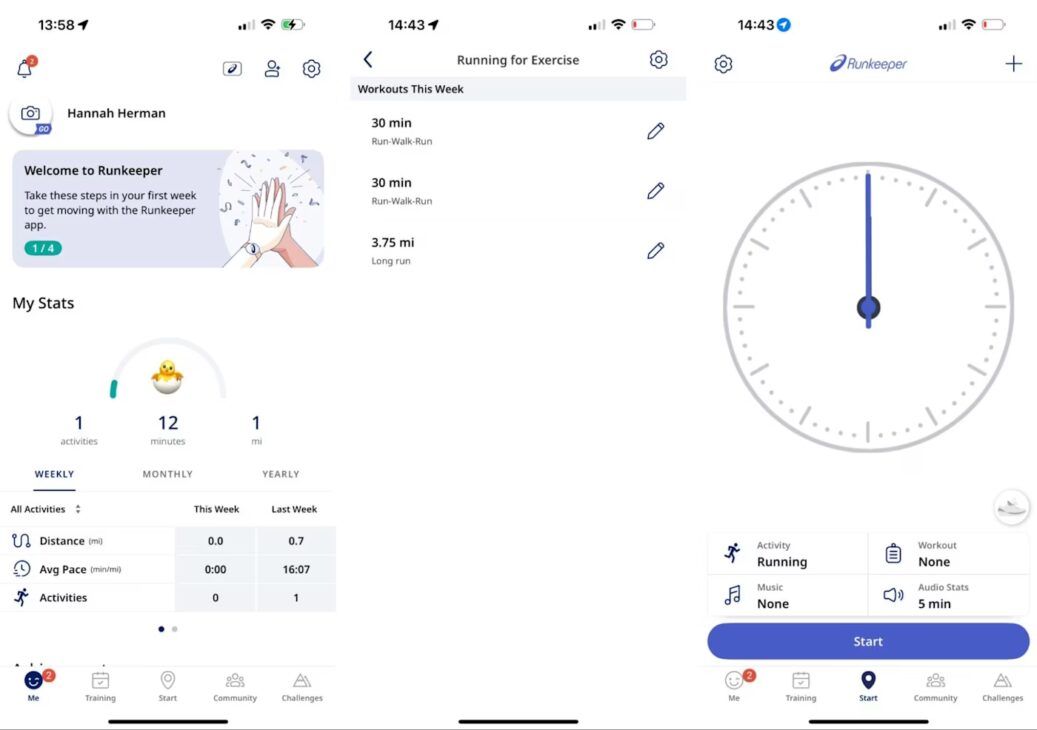
Runkeeper Pros:
- Flexible goal setting
- Shoe tracking
- Simple interface
Runkeeper Cons:
- Indoor activity tracking is limited
Runkeeper, owned by ASICS, offers a fantastic dynamic goal-setting experience. When you first launch the app, it guides you through a quick setup to define your goals. You can choose from options like running without stopping, increasing your distance, or improving your speed. This is perfect for anyone new to running, as it tailors your training plan based on your selected goal.
I particularly appreciated the shoe tracking feature, which lets you log your running shoes and reminds you when it’s time to replace them based on the miles you’ve run.
However, there’s a noticeable downside when it comes to indoor tracking. The app doesn’t provide the detailed metrics you’d expect—only time, intervals, and pace are called out, which didn’t offer much value during my treadmill test. I couldn’t see my distance or pace on the screen. The ability to manually edit my run helped, but it’s not ideal.
On the flip side, when using Runkeeper outdoors or with an Apple Watch, the app performs much better, showing the pace and other useful stats in real time.
For beginners, though, the well-designed goal-setting and training plans can make running feel achievable despite the indoor tracking shortcomings. It’s also worth mentioning that Runkeeper syncs with other apps via Zapier, letting you integrate your workouts with calendars or spreadsheets.
Runkeeper Pricing: Free; paid plans available for extra features.
Best Fitness App for Strength Training Beginners
Gymverse
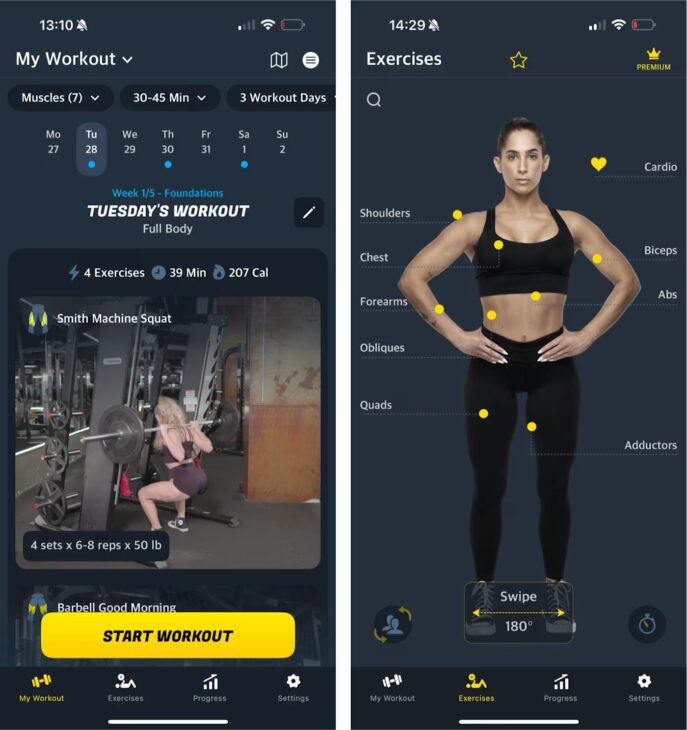
Gymverse Pros:
- Integrated video tutorials
- Personalized workout plan creation
- Excellent wearable connectivity
Gymverse Cons:
- Higher cost compared to similar apps
After using PUSH, I thought I’d seen the peak of strength training apps. Then I tried Gymverse—and it blew me away. With over 10,000 reviews and a perfect 5-star rating on the Apple App Store, it’s easy to see why this app is so popular.
Similar to other apps like Strong and Hevy, Gymverse creates a customized training plan for you. But what sets it apart is its integrated video tutorials for each exercise. These high-quality videos are incredibly helpful for beginners, making it easy to understand each move and perform it with confidence.
Gymverse also shines when it comes to wearable connectivity. When I tested it with my Apple Watch, I was able to start, track, and finish my workouts directly from my wrist without needing to open the app on my phone. Plus, with calorie tracking when paired with a wearable, Gymverse provides a holistic view of your fitness progress.
However, the app’s price is a bit of a hurdle. At $149.99 per year, it’s one of the priciest fitness apps I’ve come across—roughly twice as expensive as Strava. Still, considering that it essentially replaces a personal trainer, it might be worth the investment, especially if you’re working out at home or on a budget gym membership and need extensive guidance.
Gymverse Pricing: Free for basic features; paid plans starting at $23.99/month
The Best Fitness App is the One That Works for You
At the end of the day, the best fitness app is the one you’ll actually use—and continue to use. Fitness is a personal journey, and what works for one person might not be right for another. Whether you prefer hiking, cycling, or even tricycling (though I didn’t dive into that for this article), there’s likely an app that fits your needs.


